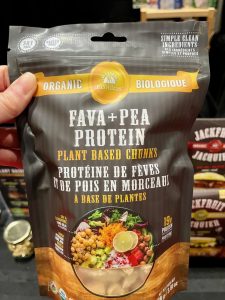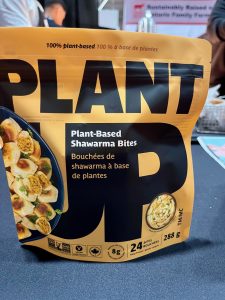
According to Statista, 50 to 72% of Canadians say that it’s a positive choice to eat more plant-based foods. Food companies are listening. At this year’s Restaurants Canada show in Toronto, plant-based food innovations were indeed THE biggest trend.
Here are a few of the plant-based foods I spotted at the show.
Ecoideas – Plant-based Chunks
 These dried chunks are vegan, gluten-free and made from organic fava and pea protein concentrate. After soaking the chunks in hot water, they’re ready to use in recipes. The company also produces plant-based crumble and jackfruit cubes/shreds.
These dried chunks are vegan, gluten-free and made from organic fava and pea protein concentrate. After soaking the chunks in hot water, they’re ready to use in recipes. The company also produces plant-based crumble and jackfruit cubes/shreds.
Nutrition info for 3/4 cup serving: 130 calories, 1.5 g fat, 11 g carbohydrates, 5 g fibre, 1 g sugars, 19 g protein, 0 mg cholesterol, 180 mg sodium, 15% DV potassium, 4% DV calcium, 19% DV iron (DV= Daily Value).
PLANT UP – Plant-based Shawarma Bites
 Made from soy protein and chickpeas, these little bite snacks pack in a blend of Middle Eastern flavourings. The company partnered with chefs around the world to create a range of products including plant-based Asian dumplings, Thai Basil Chik’n, and Butter Chik’n Bites.
Made from soy protein and chickpeas, these little bite snacks pack in a blend of Middle Eastern flavourings. The company partnered with chefs around the world to create a range of products including plant-based Asian dumplings, Thai Basil Chik’n, and Butter Chik’n Bites.
Nutrition info for 7 plant-based Shawarma bites: 150 calories, 7 g fat, 24 g carbohydrates, 2 g fibre, 3 g sugars, 8 g protein, 0 mg cholesterol, 420 mg sodium, 1% DV potassium, 2% DV calcium, 19% DV iron (DV = Daily Value).
Plantropy – Jackfruit Pepperoni

Jackfruit is a tropical fruit with a meat-like texture. It’s a common ingredient used in plant-based alternatives to meat. Pea protein is added to boost the protein content. The company also offers jackfruit dumplings, nuggets, kebabs and pulled jackfruit.
Nutrition info for 20 pepperoni slices: 180 calories, 14 g fat, 9 g carbohydrates, 2 g fibre, 6 g sugars, 5 g protein, 0 mg cholesterol, 430 mg sodium, 7% DV potassium, 3% DV calcium, 17% DV iron (DV= Daily Value).
Woop 4 – Plant-based Fish

Made from rice protein, canola oil, flaxseed oil and konjac, this fish alternative requires no cooking. Sweet potato and carrot powder are added to mimic the colour of fish. The product is marked as allergy-free and can be used in sushi, sashimi and poke dishes.
Nutrition info for 125 g serving: 120 calories, 9 g fat, 4 g carbohydrates, 0 g fibre, 1 g sugars, 5 g protein, 0 mg cholesterol, 180 mg sodium, 1% DV potassium, 10% DV calcium, 7% DV iron (DV= Daily Value).
Are you interested in eating plant-based foods? Would you try these products? Let me know in the comments.
This information is for educational purposes only. This is not a sponsored post and not intended to be an endorsement of these products.


